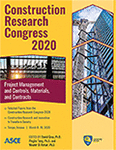Construction Research Congress 2020
Design for Disassembly: An Analysis of the Practice (or Lack Thereof) in the United States
Publication: Construction Research Congress 2020: Project Management and Controls, Materials, and Contracts
ABSTRACT
Construction consumes more resources and generates more solid waste than most industries. Recycling building components and their materials is not enough to eliminate solid waste and promote resource efficiency. The circular economy (CE) prioritizes reuse over recycling and proposes systemic changes in the way we build. Designing out waste is the core principle of the CE. Design for disassembly or design for deconstruction (DfD) is the practice of planning the future deconstruction of a building and the reuse of its materials and components. However, there are very few buildings in the world that have been designed to be disassembled. The study presented in this paper aims at identifying the barriers and opportunities for DfD and building components’ reuse in the current design practice in the United States. The authors recorded, transcribed, and coded open-ended interviews with 13 architects from large design firms in the United States to answer the question of why architects do not currently design for disassembly. Data were analyzed with a grounded theory approach. The authors identified several barriers, among them: building owners’ values, the challenges of a DfD-centered life cycle cost analysis, the lack of understanding about the environmental benefits of reuse (e.g., over recycling), and the architects’ conflicting views about resiliency and disassembly. Prefabrication and product-service systems have emerged as opportunities for DfD and CE in the built environment.
Get full access to this article
View all available purchase options and get full access to this chapter.
REFERENCES
BNP Media. (2018). “2014 Top 300 Architecture Firms.” Architectural Record, <https://www.architecturalrecord.com/Top300/2014-Top-300-Architecture-Firms-1> (Sep. 20, 2019)
Charmaz, K. (2014). Constructing grounded theory. Sage, Thousand Oaks.
Chini, A. R. (2005). Deconstruction and Materials Reuse – an International Overview. CIB Publication, University of Florida, 300.
Cruz Rios, F. (2018). “Beyond Recycling: Design for Disassembly, Reuse, and Circular Economy in the Built Environment.” Ph.D. Dissertation, Arizona State University. <https://repository.asu.edu/items/50567>
Dolan, P. J., Lampo, R. G., & Dearborn, J. C. (1999). “Concepts for Reuse and Recycling of Construction and Demolition Waste.” USACERL Technical Report 99/58, U.S. Army Corps of Engineers.
Ellen MacArthur Foundation. (2013). Towards the Circular Economy. Ellen MacArthur Foundation.
Grbich, C. (2013). Qualitative Data Analysis: An Introduction. Sage, Thousand Oaks.
Goedkoop, M. J., Van Halen, C. J. G., Te Riele, H. R. M., & Rommens, P. J. M. (1999). “Product Service systems, Ecological and Economic Basics.” Economic Affairs, 36.
Guy, B., & Ciarimboli, N. (2007). Design for Disassembly in the built environment: a guide to closed-loop design and building. City of Seattle.
Kibert, C. J., & Chini, A. R. (2000). “Overview of Deconstruction in Selected Countries.” CIB Report, 252.
Kibert, C. J., Chini, A. R., & Languell, J. (2001). “Deconstruction as an essential component of sustainable construction”. Proc., CIB World Building Congress, Wellington, New Zealand, 1-11.
Kibert, C. J. (2013). Sustainable Construction: Green Building Design and Delivery, third ed., John Wiley & Sons Inc., New Jersey.
Nakajima, S. (2014). “Barriers for Deconstruction and Reuse / Recycling of Construction Materials.” CIB Publication 397, S. Nakajima and M. Russell, eds., University of New Mexico.
Pacheco-Torgal, F. (2014). “Introduction to the environmental impact of construction and building materials.” Eco-Efficient Construction and Building Materials, F. Pacheco-Torgal, L.F. Cabeza, and A. de Magalhães, eds., Woodhead Publishing Limited.
Stahel, W. R. (2016). “The Circular Economy.” Nature Comment, 1–7.
Webster, M. D., Gumpertz, S., Costello, D. T., & Co, C. D. (2005). “Designing Structural Systems for Deconstruction: How to Extend a New Building’ s Useful Life and Prevent it from Going to Waste When the End Finally Comes.” Proc., Greenbuild Conference, Atlanta, GA.
Wijkman, A., & Skånberg, K. (2015). “The Circular Economy and benefits to society.” The Club of Rome. <https://www.clubofrome.org/wp-content/uploads/2016/03/The-Circular-Economy-and-Benefits-for-Society.pdf>
Zhao, W., Leeftink, R. B., & Rotter, V. S. (2010). “Evaluation of the economic feasibility for the recycling of construction and demolition waste in China: The case of Chongqing.” Resources, Conservation and Recycling, 54(6), 377–389.
Information & Authors
Information
Published In
Construction Research Congress 2020: Project Management and Controls, Materials, and Contracts
Pages: 992 - 1000
Editors: David Grau, Ph.D., Arizona State University, Pingbo Tang, Ph.D., Arizona State University, and Mounir El Asmar, Ph.D., Arizona State University
ISBN (Online): 978-0-7844-8288-9
Copyright
© 2020 American Society of Civil Engineers.
History
Published online: Nov 9, 2020
Published in print: Nov 9, 2020
Authors
Metrics & Citations
Metrics
Citations
Download citation
If you have the appropriate software installed, you can download article citation data to the citation manager of your choice. Simply select your manager software from the list below and click Download.
